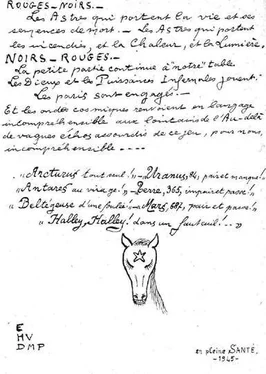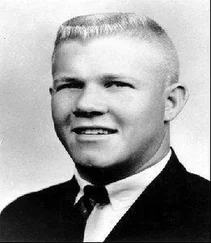The next witnesses were no more helpful in unraveling the complicated affair. Both René Nézondet’s girlfriend, Aimée Lesage, and her friend, Marie Turpault, confirmed that Nézondet had told them about the bodies Maurice Petiot had found at rue Le Sueur. Lesage added that Georgette Petiot knew about them as well because Nézondet had told her in Aimée’s presence. As a nurse, Lesage was also convinced that Madame Petiot’s fainting bouts were contrived. Georgette Petiot, she believed, knew all along what her husband was doing.
The defense would dismiss this testimony as simply a witness protecting her boyfriend. The prosecution had not found any credible evidence, Floriot emphasized, to suggest that Georgette Petiot had any reason to doubt that her husband worked for the Resistance. Besides, despite the claims made on the stand that afternoon, no German uniforms were found in the suitcases, the basement closets of rue Le Sueur, or at any of Petiot’s other properties around the capital.
“The longer this trial goes,” Petiot said at this point, “the more confusing it becomes.”
“Voilà,” Leser said, to the amusement of the audience.
THE testimony of suspected recruiters and accomplices continued on the tenth day of the trial, when Eryane Kahan took the stand, looking every bit as glamorous as the newspapers had reported. Tall, with strawberry blond hair, Kahan wore a wide-lapeled brown suit, a wool crew-neck sweater, long silk gloves, and a fashionable round hat trimmed with otter fur and tipped at a slight angle. She walked up to the front of the courtroom slowly, carrying a stylish handbag. Her dark-tinted glasses made her resemble an incognito Greta Garbo. She looked like she was in her late twenties or early thirties, rather than her actual age of fifty.
This mysterious woman was suspected of sending nine victims, all of them fellow Jews, to the escape network. The defense would try to show that she worked for the Gestapo and only sent Petiot traitors attempting to infiltrate his organization. The prosecution would take the position that Kahan could have worked out of any number of motives, ranging from a desire for commission profit, to the altruistic hope that she was helping desperate people escape the Nazi Occupation. For the prosecution, she was no collaborator, and more to the point of the trial, neither were the people she sent Petiot. Audience and jury alike would hang on every word of this important witness.
Kahan was visibly nervous as she started to testify. In a husky voice with a strong Slavic accent, she described how she first met Petiot through her friend and lover, Dr. Saint-Pierre, a physician well known in the underground for his criminal clients and connections. The meeting took place in a back room at Fourrier’s hair salon, where Dr. Eugène, as she put it, questioned her about “the circumstances of my friends and me.” She admitted referring the Wolff, Basch, and Schonker families to the escape organization. All of these people, she said, were delightful.
Given the portrayal of these families by the defense, Leser asked the witness if they were really opposed to the Nazis.
“Of course, Mr. Président,” Kahan said. “They were not only anti-Nazi, but they also lived in terror of being arrested. There was no doubt of their sentiments.” Each of the Jewish families was so happy about the opportunity to leave Occupied Paris that they viewed Petiot “as their God.” They had praised the altruistic Frenchman who operated the escape agency, at great personal risk, to help Jews that he did not know. One journalist in the audience noted that the defendant stopped staring absentmindedly at the ceiling when he heard these words and looked like he felt a sudden sharp pain in his chest.
Kahan also testified to her desire to leave Paris, but Petiot had opposed it for the reason that she could be useful to the Resistance movement. “I understand now what a wonderful pawn I was.”
The witness proceeded to describe how she had adored Dr. Eugène for his patriotic work on behalf of the Resistance. Even when the story broke in March 1944, she testified, she had not made a connection. She had never known him under the name Marcel Petiot, only Dr. Eugène, and all the talk of “injections, nightclubs, drugs, loose women” did not match the man she knew, who was “serious, levelheaded, composed, and very sensible.” It was his photograph on the front page, she said, that caused her to discover the horrible truth.
As for why she did not simply go to the police with her story if she were as innocent as she claimed, Kahan reminded the prosecution that, as a Jew in the Occupation, she was “hunted as a harmful beast.” At one point, she had considered going to the police, but she said that the attorney she consulted, René Floriot, advised her to “stay put.”
Kahan’s story and her motives were soon questioned by Floriot, and a spirited debate followed over her professed work for the Resistance. She became defensive. She struck the railing with her fist, and as she appeared flustered, her accent became more pronounced. Dupin came to her aid, noting that the police had found no evidence disputing her claims of having served the Resistance.
Floriot asked about a certain police report dated November 30, 1945, that identified Eryane Kahan as “an adventuress … who lies with skill.” In the interviews following her arrest as an alleged Petiot accomplice in the autumn of 1944, Kahan could not name a single person she had worked with in the Resistance—and again, this was after the Liberation, when there was no lack of people claiming this distinction. Kahan had been found, Commissaire Poirier noted, with “many difficulties.” Indeed, she was living in the 16th arrondissement, under the fake name of Odette Motte.
Another thing that Floriot knew was that the former leader of the French Gestapo, Henri Lafont, had picked her out from a list of photographs as a woman who had informed his gang about the activities and whereabouts of fellow Jews. Specifically, in a deposition signed December 21, 1944, Lafont stated that Kahan “came to us to give tips on the passages to Spain arranged by a doctor.”
It was a lengthy cross-examination accompanied by a duel of glasses, as Floriot and Kahan removed and wiped their spectacles at regular intervals. Floriot focused first on establishing that Kahan had received a commission for every person she sent Dr. Petiot. He hounded the witness, citing the police report and the testimony of several witnesses. But Kahan refused to budge, and a heated exchange erupted between prosecution and defense attorneys. Insults and insinuations flew from both sides, prompting Leser to call a recess. When the court returned, Dupin withdrew his comments, which might have “offended the very legitimate sensitivities of my opponent.”
Floriot nodded and then launched into a series of rapid-fire questions, suggesting that Kahan had enjoyed a close relationship with Occupation authorities. He asked about her friend, the German officer, and the fact that she had been seen riding in a German truck, which she could not deny. Her apartment building, Floriot continued, was often visited by three or four German officers. He mentioned the deposition of a former friend who believed that Kahan caused her husband’s arrest by the Gestapo. Kahan countered that she had never heard that before.
When Floriot asked about Madame Cadoret’s testimony, namely that she had been worried when Kahan was “saluted by a number of German soldiers,” Kahan said that this was simply her friend Herbert Welsing and one or two of his Luftwaffe friends. Floriot noted that her memory had suddenly returned.
There was one last question, Floriot said. Kahan had been accused of “intelligence with the enemy” (Article 75 of the penal code), but what had happened to her dossier? Kahan denied having any knowledge of such a file. Jean-François Dominique, then covering the trial for Toulouse’s La Républic du Sud-Ouest , thought that she was taken aback by the question.
Читать дальше












